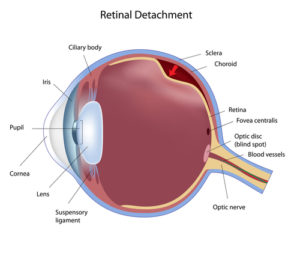
If the U.S. Department of Veterans Affairs (VA) denied your claim for detached retina veterans’ benefits, you have the right to appeal this decision. The appeals process can be complex and confusing, but a veterans’ disability advocate can help you obtain the benefits you deserve. Contact a veterans’ disability advocacy group for a free and confidential consultation today at (888) 373-4722.
Obtain Retinal Detachment Veterans’ Benefits
Retinal detachment occurs when the retina pulls away from its normal placement on the eye. When this separation occurs, the retina is cut off from the nourishment it requires to continue working properly. If left untreated for too long, you may suffer permanent vision loss in that eye.
Retinal Detachment Symptoms
Symptoms of retinal detachment may include:
- “Floaters” — the appearance of small particles in your line of vision
- Photopsia — small, sudden flashes of light
- Reduction in peripheral vision
- Blurred vision
- A shadow over your line of vision
Three Types of Retinal Detachment
- Rhegmatogenous: The most-common of the retinal detachments, rhegmatogenous detachments result from a retinal rip that allows fluid to enter and pool underneath the retina. Aging is the most common cause of this type of retinal detachment, but it can also be a result of trauma to the eye area.
- Tractional: When scar tissue develops on the surface of the retina, it may result in detachment. Poorly-controlled medical conditions, such as diabetes, are often associated with tractional detachment.
- Exudative: Trauma to the eye area, as well as tumors and other medical conditions are commonly associated with exudative retinal detachment. Tears and holes are not present in this type of separation. Rather, exudative detachments are the result of fluid accumulating under the retina.
Appeals Must Establish Three Criteria
To succeed in an appeal of a VA denial, three criteria must be present.
Current Diagnosis of a Retinal Detachment
You must have received an official diagnosis of retinal detachment, and the diagnosis must still be current. Further, this diagnosis cannot be based on anecdotal evidence from family or co-workers: it must be from a medical professional with specialized knowledge qualifying them to give the diagnosis.
You Must Have Experienced a Traumatic Event or in-service onset
VA will deny claims with no evidence that the current diagnosis began in service or is related to an event that occurred during service. Did a specific in-service event cause or contribute to your retinal detachment? It is not enough to say that the retinal detachment occurred during service. You must be able to identify a specific event that contributed to or caused the condition. For example, did someone physically assault you, causing damage to your retina? Such an occurrence may qualify as an in-service event.
Direct Link Between the In-Service Event and Your Retinal Detachment
Once it has been established that your retinal detachment may have been caused or worsened by an in-service event, you must be able to show a link between your diagnosis and the in-service event. This link is referred to as a nexus.
Proving the nexus is arguably the most challenging part of the appeals process, but it may also be the most important. Without a nexus, the appeal does not stand a chance. Fortunately, a veterans’ disability advocate can help to gather the evidence you need and fight to get you the most favorable outcome possible.
Determining Retinal Detachment Compensation
Determining the amount of compensation that may be available is generally of significant importance to any veteran suffering from a disability. To calculate this compensation, VA issues a disability rating based on certain criteria. With regard to retinal detachment, the schedule of ratings is as follows:
Evaluate on the basis of either visual impairment due to the particular condition or on the incapacitating episodes, whichever results in a higher evaluation:
- 60% rating: “With documented incapacitating episodes requiring 7 or more treatment visits for an eye condition during the past 12 months”
- 40% rating: “With documented incapacitating episodes requiring at least 5 but less than 7 treatment visits for an eye condition during the past 12 months”
- 20% rating: “With documented incapacitating episodes requiring at least 3 but less than 5 treatment visits for an eye condition during the past 12 months”
- 10% rating: “With documented incapacitating episodes requiring at least 1 but less than 3 treatment visits for an eye condition during the past 12 months”
The Monthly Benefits You Can Expect to Receive Based on Your Rating
How does t VA use the above ratings to calculate monthly disability compensation? As of late 2019, the veterans’ disability rates are as follows for a single veteran with no dependents:
- 60% disability rating: $1,131.68 per month
- 40% disability rating: $627.61 per month
- 20% disability rating: $281.27 per month
- 10% disability rating: $142.29 per month
Contact a VA Disability Advocacy Group Today to Get Help Recovering Your Maximum Monthly Compensation for Retinal Detachment
If you are suffering from a retinal detachment that was sustained during military service, you deserve to be compensated for your injuries. Obtaining the detached retina veterans benefits you are entitled to can be a challenge but rest assured that you are not alone. A veterans’ disability advocate can help you navigate this complex process so that your focus can be on healing.
Contact a veterans’ disability advocacy group today at (888) 373-4722. Do not go through this difficult time alone. A veterans’ disability advocate can help you get the compensation you deserve so you can get your life back on track.



